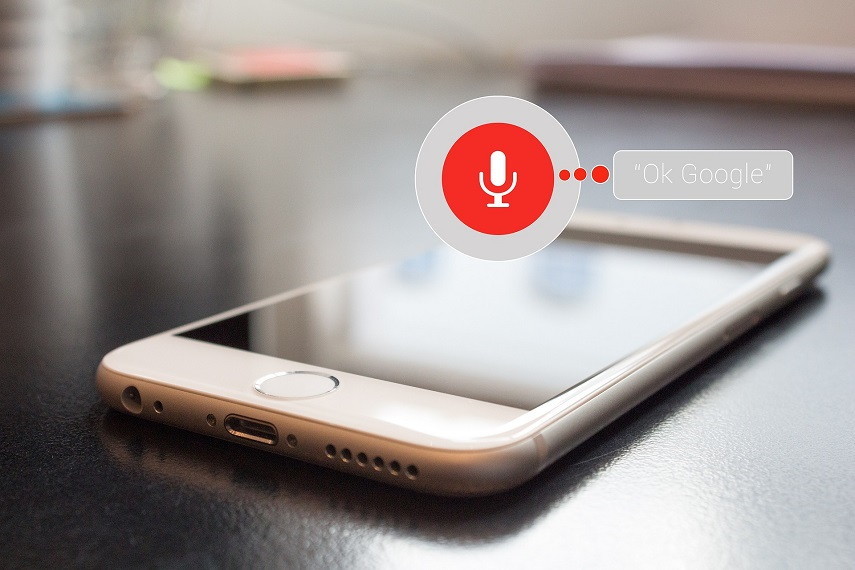Customers have always used their voices to ask for more information or to purchase a product or service, right? Whether in a brick-and-mortar store or via phone call, it’s common for people to talk to and chat with consultants, salespeople, or cashiers.
But why has this not yet caught on in e-commerce? If we bear in mind that chatbots are now part of the day-to-day relationship of stores and their customers and that a great many consumers are now used to sending voice messages using messaging apps to their contacts, why not combine these two resources?
Additionally, there are several other factors to this scenario, such as voice search. After all, a good many smartphone users have already searched for something just by relaying the infamous phrase “ok, Google.” The technology that enables people to do searches using their voices to consult a route, get information about the weather, or look for specific content on Google has been around for some time.
Not to mention the increasing use of voice-managed home help devices like Google Home and Amazon Echo.
Lastly, a series of simple routine tasks now commonly get done using voice-machine interaction. Therefore, it is evident that voice commerce appears to be the natural way forward for the retail sector. In this article, we will get a better understanding of the application and its challenges.
Voice Commerce: The Next Step for the Retail Sector
In spite of all the tone of innovation that this concept brings, voice purchases will be yet another way for stores to sell to the public. The channels, like message apps and voice assistants, will be the same and at the most will undergo minor adaptations.
For example, if on Facebook Messenger people are already able to purchase using chatbots, then it’s also possible to add the voice interaction option. The same can be said for Amazon’s Alexa, where people can now place a purchase order instead of just requesting a simpler task, such as reproducing a music playlist. On that point, 1 in every 5 consumers in the USA has already purchased something using a voice-controlled device such as Amazon Echo, according to the 2017 Future of Retail study by Walker Sands.
Also, a study published by CNBC indicates that Alexa could become a 10-billion-dollar business by 2020.
The bottom line is that the technology already exists, and it’s there to be used for the purpose of facilitating product sales. It is very likely that this option will become popular even more quickly than we previously imagined.
Characteristics of Voice Commerce
To better understand how this resource will grow in popularity, we are going to highlight some of its main features:
Automation for Repeat Customers
Before we go any further, let’s be clear that voice-activated purchases will apply to repeat customers of a store. This mechanism will not apply to first-time buyers.
The reason is simple: first-time purchases require registration of the customer’s personal, home, and banking information. Voice-activated purchases will not happen without prior recognition of the buyers’ habits, personal information, and their voices.
And why are habits so important in this case? The idea is for maximum automation of the purchase process. For example, the customer enters a chat room with supermarket e-commerce and/or requests its voice assistant to purchase a toothbrush. Thereafter, the following steps are to confirm the assistant’s suggestion, automatically close out the purchase, and on the part of the retailer, dispatch the delivery to the customer’s address.
Differentiated Purchase Experience
When we study and talk about UX, we are considering the ideal and standard path for a store’s customers. This route, also known as the “happy path,” portrays the natural path people take when concluding a purchase.
It is based on that customer’s data and their habits. So, if a person habitually purchases using the same card, send the orders to the same address, pays cash for products costing less than R$100.00, and is always searching for same-brand offers, a path can be traced out based on this behavior.
It is also worth mentioning that other criteria can be used in this automation, such as product measurements and purchase frequency, among other personal preferences.
This path will guide the voice-activated purchase process, making it quicker, more efficient, and more convenient for customers. Consumers can, for example, order headache medication while driving, stuck in traffic, returning from work and, once they get home, receive the product or wait a short time to have the order delivered. And all of this is possible without going to checkout while eliminating several steps in the process.
Simplification and Higher Sales in Various Categories
There are several market segments that tend to benefit from voice commerce. Here, worthy of note are offers usually purchased on impulse, out of habit, or without many criteria.
Below, you will see a video demonstrating the use of Amazon’s Alexa, showing some examples of purchases that the machine recognizes by voice and can process individually, such as the request to buy dog meal or rubbish bags.
Now, think of how pizza parlors, snack bars, pharmacies, and supermarkets stand to gain from selling their products via voice assistants and message apps. After all, in most cases, we are talking about purchases that do not require too many visual criteria to complete, and which are already accustomed to being purchased through telesales. Voice Commerce, then, becomes the natural path for these transactions, with more precise 24×7 authentication without the need for human intervention.
The Main Challenges of Voice Commerce
Since we are talking about a technology that already exists and provides benefits to consumers, such as improvements to the UX, and for store owners, like shortening the selling process, what is missing for it to be used by most electronic commerce players?
Being a Method Familiar to Consumers
The first challenge involves disclosing this tool to the public. Indeed, although indicated as a trend, voice assistants are not used by the vast majority of customers when making purchases.
On the internet, the clicks, typing, and keystrokes on the screen are still the most common means by which people interact with stores.
Maybe it’s just a question of time until people become adjusted to this or understand that they can also use their voice to chat with companies (and with machines, not humans) to speed up their demands.
Being Seen by the Stores as Something Easy to Apply
One of the reasons why voice commerce is still not in greater use by customers may also be the fact that businesses are not (yet) making this method available. In this case, the missing factor is how simple it is to implement this tool.
There will be no need to tweak the site or create an application just to “chat” with consumers. Hiring a company that already works with chatbots, and integrates via API with message apps or voice assistants, is the more natural way forward.
Although a pricey investment, it is a project that will take no more than a few months to set up.
Once companies consult and use the already existing APIs, they will not have to become directly involved in teaching these voice-activated systems.
What’s more, recognition, slang, regionalisms, and speech intonations is are aspects in which voice assistants have substantially improved with every upgrade, making the relationship with users increasingly humanized.
This enhancement is such an obvious consequence that we cannot actually characterize it as a real challenge. To have an idea of how this happens, it’s worth checking out an article published by Quartz, which shows the revolution of Google’s Tacotron 2 text speech system.
Conclusion: What Can We Expect of Voice Commerce in the Near Future?
Conversational commerce already exists, and its evolution marks the arrival of voice as a means of expanding interaction previously limited to keystrokes and clicks.
The interesting thing about this new departure is not only to get people talking to machines, but also to get the bots to interact among themselves. We can already see, for example, the virtual assistants Cortana, of Microsoft, and Alexa, of Amazon, working together in some tests. Very soon, it will be run of the mill for assistants to place orders by voice with other devices.
Also worthy of mention is the ownership of the devices as the most important asset of voice commerce. In this case, we are referring to the voice assistant devices such as Amazon Echo and Google Home. This shows how voice will also become a sales channel, not just a method.
This movement will be a relevant one because creating a new channel will create new routes for performance media and their respective investments. In addition, we will be able to witness the zenith of the marketplace as it also expands to voice devices.
Voice-controlled electronic commerce is an increasingly closer reality, and both companies and consumers will have to get used to this “old” method of placing orders.







